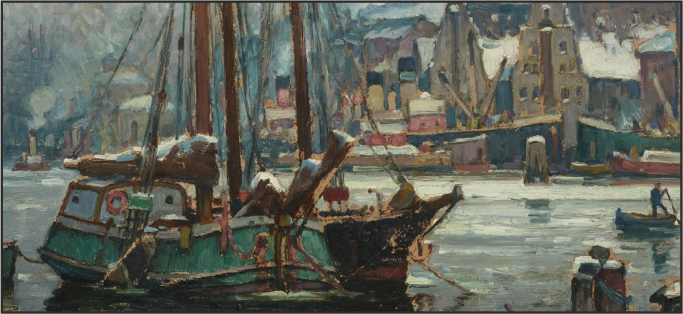The small-scale exhibition features paintings by Hans Hartig in the collection of the National Museum in Szczecin, as well as the latest acquisition, "Fishing Wharf in Winter" from the 1910s.
The exhibition is complemented by photographs and postcards from the collection of Zenon Owczarek from Nowe Warpno, a researcher into the artist's life and work. The exhibition was created as an element of the museum's programme of events to mark the 150th anniversary of the painter's birth (5 October 2023).
Hans Hartig (1873 Carvin, present Karwin – 1936 Berlin)
Hans Hartig's first drawing lessons were given by Theodor Kugelmann, the Szczecin painter and drawing teacher at the St. Mary's Foundation Gymnasium in Szczecin. In 1894, he continued his studies as a free student in the landscape class of Paul Vorgang at the Royal Prussian Academy of Fine Arts in Berlin. After one year's military service in the 2nd Grenadier Regiment of Friedrich Wilhelm IV in Stettin, he returned to Berlin and in 1899 rejoined Paul Vorgang's landscape class, and in the following academic year he was placed in the master class of Eugen Bracht, regarded in Berlin circles as a pioneer of plein air painting. He run outdoor classes with his students, emphasising the importance of light and the relationship between light and colour in painting.
Hartig's first significant achievement was the exposition of his painting "The Valley of the Oder" in Eugen Bracht's hall at the Great Berlin Exhibition in 1901 and its soon purchase for the collection of the Berlin National Gallery. After Bracht moved to the Royal Saxon Academy of Fine Arts in Dresden in 1902, Hartig, like other students, followed his master to continue to study under his tutelage.
After having graduated from his studies in 1906, Hartig returned to Berlin, where he settled permanently. He decided to specialise in views of Pomeranian cities, towns and villages and their ancient architecture. His painting compositions were based on numerous sketches and drawing studies, and he also liked to photograph motifs for his future paintings. Hartig's maritime paintings were highly acclaimed, and he was also very popular for graphic reproductions of his paintings. In 1909, he took part in the exhibition of German art in New York with his "View of the Harbour in Winter", and in 1910, at the annual exhibition of the Great Berlin Exhibition, he won a prize from the Royal Prussian Academy of Fine Arts for his painting depicting a seaside autumn garden, which enabled the artist to have a studio stay on the island of Sylt in 1911.
In 1913 he participated in the Venice Biennale and in 1914 he was given the honour of guiding Kaiser Wilhelm II at the Great Berlin Exhibition. He became a recognised and respected official painter, exhibited a great deal, his works were sold in Europe and the United States.
artig constantly maintained contact with Szczecin and Pomerania, visiting Gartz an der Oder, Trzebiatów, Gryfice, Nowe Warpno. He liked to paint harbour views full of boats and ships. In 1916, he became a co-organiser and member of the Pomeranian Artists' Association (Pommerscher Künstlerbund), founded in Szczecin. In 1932 he received an honorary award from the Berlin Artists' Association (Verein Berliner Künstler).
He began to withdraw from active participation in artistic life after the Nationalist party came to power. Towards the end of his life, suffering from a heart illness, he created still lifes at home and made replicas of his earlier paintings. He died in February 1936 at his home in Berlin-Schöneberg and was buried in the local cemetery at the Church of the Twelve Apostles.
